2ª Sessió del cicle:
Curating Pathology at the Musée Charcot
a càrrec de Natasha Ruiz-Gómez
(University of Essex)
Dimecres, 24 de gener de 2018, a les 19.00 h
a l’Institut d’Estudis Catalans,
(carrer del Carme, 47, Barcelona)
Musée Charcot. Paris, ca. 1894.
Entrevista: Hablamos con Natasha Ruiz-Gomez
El cicle “Objectes Perduts”: La SCHCT ofereix una nova edició del cicle de col·loquis dedicats a reflexionar sobre el patrimoni científic, els significats de la materialitat i el potencial evocador i explicatius de la cultura material de la ciència. En aquesta edició fixem la mirada en la creació d’objectes científics i en els seus règims d’exhibició: qui i com els crea, quins usos tenen, com circulen i, aleshores, com es transformen i creen nous significats per part de nous públics.
El cicle planteja enguany tres presentacions centrades en el procés de comprensió del patrimoni i en la seva posada en escena: l’escultura funerària i el cementiri com a espais relacionats amb les pràctiques mèdiques de les sales de dissecció anatòmiques a la Barcelona del segle XIX; la cultura material de les malalties nervioses i la creació d’objectes de ciència artístics al París fin-de-siècle; i la complexitat dels escenaris o dels règims d’exhibició on té lloc l’espectacle dels cossos humans.
Resum de la conferència: The Hôpital de la Salpêtrière was at the center of the hysteria ‘epidemic’ in late-nineteenth-century Paris, but its museum of pathological anatomy, the so-called Musée Charcot, exhibited photographs, drawings, skeletons, anatomical specimens, casts and sculptures of ‘artistic pathology’ that depicted other, more disquieting illnesses. Founded by artist-manqué Dr Jean-Martin Charcot (1825-1893), head of the hospital’s medical service for over thirty years and one of the founders of modern neurology, the museum was populated by works created by the many doctors whose artistic sensibilities were nurtured by Charcot.
The Musée Charcot offered a partial and idiosyncratic vision of nervous disease. The only known photograph of this museum, which is no longer extant, shows a curious group of objects and images, which coalesce under the umbrella of medical evidence. If illumination was the presumed goal of the anatomical museum since the Enlightenment, the exhibits here more often resulted in the obfuscation of pathology. In addition to shedding light on this space of curated morbid anatomy, this talk focuses on the mostly unknown and unpublished albums from the Musée Charcot’s collection that replicate the museum’s methodology in miniature. In these ‘lost objects’, accomplished drawings and enigmatic photographs compete with more ‘objective’ graphs and diagrams to represent the pathologies seen at the Salpêtrière. Like the anatomical specimens, sculptures, wax casts, medical equipment and reproductions of artworks in the museum—or the objects in an early modern Wunderkammer—the contents of the albums cohere only when seen as the collection of a single individual: the Musée Charcot’s formidable founder.
Nota biogràfica: Dr Natasha Ruiz-Gómez is a senior lecturer in Art History at the University of Essex. She specializes in French art of the nineteenth and early twentieth centuries and is especially interested in the intersection of art and medicine. She has published in Art History, Medical Humanities, Thresholds and various anthologies, as well as in a recent exhibition catalogue of the Statens Museum for Kunst, Copenhagen. Her current book project examines the ‘scientific artworks’ of Dr Jean-Martin Charcot and the Salpêtrière School. Natasha has been the recipient of numerous fellowships, including a Research Fellowship from the Leverhulme Trust, a five-year Research Councils UK Fellowship and a Kress Curatorial Fellowship at the Brooklyn Museum. She was awarded a Medical Humanities Small Grant from the Wellcome Trust to co-host a conference in June 2014 entitled ‘Collect, Exchange, Display: Artistic Practice and the Medical Museum’ at the Hunterian Museum, London.

